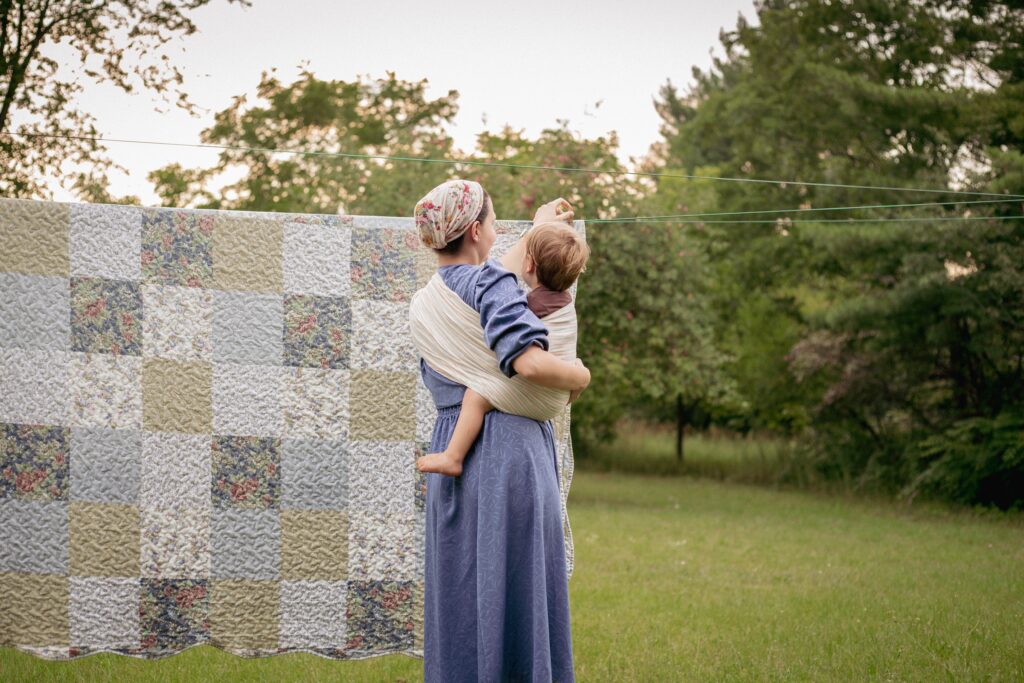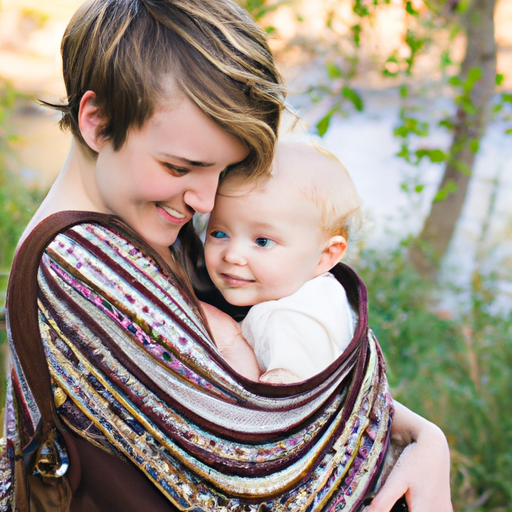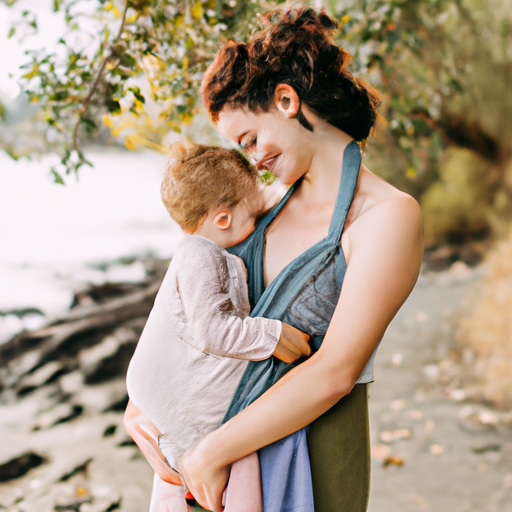In this article, you will discover how babywearing can create a strong bond between you and your little one. We will explore the benefits of wearing your baby against your body, both for you and your baby. Additionally, we will discuss the different types of baby carriers available and provide tips for safely and comfortably wearing your baby. By the end, you will have a deeper understanding of babywearing and be inspired to try it for yourself.

Benefits of Babywearing
As a parent, you want the best for your baby. You want to create a strong bond and promote their physical and emotional development. Babywearing can be a valuable tool in achieving these goals. By keeping your baby close to you throughout the day using a carrier, you can enhance bonding, promote emotional development, and boost physical development.
Enhances Bonding
One of the most significant benefits of babywearing is the enhancement of bonding between parent and child. When you wear your baby, you are providing them with a sense of security and closeness that cannot be replicated in any other way. The physical contact and constant presence of the caregiver help foster a deep emotional connection.
When your baby is in a carrier, they can hear your heartbeat and feel your warmth. This mimics the environment they experienced in the womb, creating a sense of comfort and familiarity. Being close to you also allows your baby to pick up on your facial expressions, vocal cues, and body language, which helps them develop a strong attachment to you.
Promotes Emotional Development
Babywearing has been shown to promote emotional development in infants. The closeness and physical contact provided by a carrier create a secure base from which your baby can explore the world. This sense of security gives them the confidence to be more curious and engaged with their surroundings.
When your baby is worn, they can observe your interactions with other people, engage in conversations, and experience the world from a safe perspective. This exposure to different sights, sounds, and social interactions helps stimulate their cognitive development and emotional growth.
Furthermore, the constant physical contact through babywearing provides comfort and reassurance to your baby, resulting in reduced crying and fussiness. They learn that their needs will be met promptly and that they are loved and cherished, leading to a more secure and resilient temperament.
Boosts Physical Development
In addition to the emotional benefits, babywearing also offers several advantages for your baby’s physical development. When worn in a carrier, your baby is in a natural posture with their spine and hips properly aligned, which supports their growth and development.
The close proximity to your body while babywearing also offers gentle movement and stimulation to your baby’s vestibular system, which helps in the development of balance and coordination. The upright position when in a carrier also aids in the digestion process and can help reduce symptoms of colic and reflux.
Furthermore, babywearing allows for skin-to-skin contact, which has been shown to regulate the baby’s body temperature, heart rate, and breathing. This contact helps stabilize their physiological functions and promotes healthy growth.
Different Types of Baby Carriers
Now that you understand the benefits of babywearing, let’s explore the different types of baby carriers available in the market. Each type has its own features and advantages, so you can choose the one that best suits your needs and preferences.
Ring Slings
Ring slings are a popular and versatile type of baby carrier. They consist of a long piece of fabric with two rings that can be adjusted to create a secure and comfortable hold for your baby. Ring slings are easy to use and allow for quick adjustments, making them ideal for newborns and infants.
The fabric used in ring slings is usually soft, breathable, and supportive, ensuring your baby’s comfort. The adjustable nature of the carrier allows for various carrying positions, such as cradle hold, upright front carry, and hip carry. This versatility makes ring slings suitable for both newborns and older babies.
Wrap Carriers
Wrap carriers are another popular option for babywearing. They are made from a long piece of stretchy or woven fabric that can be wrapped around your body to create a secure and snug hold for your baby. Wrap carriers offer maximum adjustability, allowing for a personalized fit for both parent and baby.
The flexibility and customizable nature of wrap carriers make them suitable for newborns and infants. The fabric provides excellent support for your baby’s developing spine and hips, ensuring proper alignment. Wrap carriers also offer multiple carrying positions and can be used for extended periods without causing discomfort.
Soft Structured Carriers
Soft structured carriers, often referred to as SSCs, are a more structured and ergonomic option for babywearing. They feature a padded waistband, shoulder straps, and a back panel that provides excellent support and distributes the baby’s weight evenly.
SSCs come with buckles and straps that allow for easy adjustments and a secure fit. They are suitable for infants and toddlers, with some models accommodating newborns with the help of an infant insert. The structured design of SSCs ensures proper support for your baby’s spine and hips, keeping them in a comfortable and healthy position.

Choosing the Right Baby Carrier
Now that you are familiar with the different types of baby carriers, it’s important to know how to choose the right one for you and your baby. Several factors need to be considered to ensure a safe and comfortable babywearing experience.
Consider Baby’s Age and Weight
The age and weight of your baby are crucial factors to consider when choosing a baby carrier. Some carriers are specifically designed for newborns, while others cater to older babies and toddlers. It’s important to select a carrier that provides adequate head and neck support for your baby’s age.
Additionally, the maximum weight capacity of the carrier should be taken into account. Ensure that the carrier can comfortably support your baby’s weight. It’s essential to consult the manufacturer’s guidelines and adhere to the recommended weight limits.
Evaluate Carrier Comfort
Comfort is vital for both you and your baby during babywearing. Consider the fit and adjustability of the carrier to ensure a comfortable experience for you. Look for carriers with padded shoulder straps and waistbands that distribute the weight evenly, preventing strain on your back and shoulders.
For your baby, ensure that the carrier offers proper support for their neck, spine, and hips. Look for carriers that hold your baby in an upright position, with their knees higher than their bottom (the M-position). This position promotes healthy hip development and prevents hip dysplasia.
Check Safety Features
Safety should be the top priority when choosing a baby carrier. Look for carriers that have been tested and comply with safety standards. Check for sturdy construction, secure buckles and straps, and reinforced stitching.
Inspect the carrier for any wear and tear regularly, especially if you are using a secondhand carrier. Ensure that all fastenings are in good working condition and that there are no loose threads or frayed fabric. Following the manufacturer’s guidelines and instructions for proper use is crucial to ensure the safety of your baby.
Steps to Properly Wear Your Baby
Once you have chosen the right carrier, it’s important to learn how to wear your baby correctly. Proper positioning and adjusting of the carrier are essential for your baby’s safety and comfort. Here are the steps to properly wear your baby:
Positioning the Baby
Start by positioning your baby in the carrier. Ensure that their face is visible and clear of any fabric or obstruction. For newborns and infants, their face should be close enough to kiss. Check that their airway is clear and free from any blockage.
Hold your baby securely and gently slip them into the carrier, maintaining their natural spine curvature. Ensure that their back is fully supported, and their hips and legs are in a spread squat position. Make any necessary adjustments to ensure a comfortable and secure fit.
Adjusting the Carrier
Once your baby is positioned properly, it’s time to adjust the carrier to fit your body comfortably. Start by adjusting the waistband, ensuring that it sits snugly around your waist or hips. Secure any buckles or fastenings to hold the waistband in place.
Next, adjust the shoulder straps to distribute the weight evenly across your shoulders and back. Tighten or loosen the straps as needed to achieve a comfortable and secure fit. The carrier should feel snug but not too tight, allowing you to move freely without any strain.
Ensuring Proper Support
After positioning and adjusting the carrier, it’s important to ensure that your baby is well supported and safe. Check that their head and neck are supported, especially for newborns who have limited head control. Ensure that their chin is not pressed against their chest, as this can restrict their airway.
Check that your baby’s hips and legs are in a spread squat position, with their knees higher than their bottom. This position allows for healthy hip development and ensures proper alignment. Make any necessary adjustments to create a comfortable and secure hold for your baby.

Tips for Comfortable Babywearing
While babywearing can be a wonderful experience, it’s important to ensure your comfort as well. Here are some tips for comfortable babywearing:
Maintain Good Posture
Maintaining good posture is vital to prevent strain on your body while babywearing. Stand tall with your shoulders relaxed and your core muscles engaged. Avoid rounding your shoulders or arching your back, as this can lead to discomfort and potential back pain.
If you feel any discomfort or strain, readjust the carrier and your posture. A proper fit and positioning of the carrier will help distribute your baby’s weight evenly and minimize any discomfort.
Use a Supportive Carrier
Choosing a carrier with proper support is essential for your comfort. Look for carriers that have padded waistbands and shoulder straps to provide cushioning and prevent unnecessary pressure on your body. The carrier should fit snugly and securely, avoiding any excessive bouncing or shifting.
Try out different carriers to find one that works best for your body shape and preferences. Each person’s body is unique, so what works for one parent may not necessarily work for another. Finding the right carrier will ensure a comfortable and enjoyable babywearing experience for both you and your baby.
Distribute Weight Evenly
Distributing the weight evenly is crucial for your comfort while babywearing. Ensure that the carrier is properly adjusted and that the weight is distributed across your shoulders, back, and hips. Avoid carrying all the weight on one side, as this can lead to muscle strain and discomfort.
Regularly check and readjust the carrier to maintain even weight distribution. As your baby grows and gains weight, you may need to make slight adjustments to ensure continued comfort and safety.
Bonding Activities while Babywearing
Babywearing provides an excellent opportunity for bonding with your baby. Here are some bonding activities you can engage in while babywearing:
Talking and Singing to Your Baby
While wearing your baby, engage in conversations and sing songs to them. Your baby loves to hear your voice and will be comforted by the familiar sound. Talk about your day, sing their favorite lullabies, or simply narrate your surroundings. This interaction promotes language development and strengthens the bond between you and your baby.
Engaging in Skin-to-Skin Contact
Take advantage of the skin-to-skin contact offered by babywearing. Remove any additional layers of clothing to allow direct skin contact between you and your baby. This form of physical touch releases oxytocin in both you and your baby, strengthening the emotional bond.
Skin-to-skin contact has numerous benefits, including regulating your baby’s body temperature, promoting breastfeeding, and providing a calming effect. Enjoy the intimacy and closeness that babywearing brings through skin-to-skin contact.
Going for Outdoor Walks
Take your baby for outdoor walks while babywearing. Being close to nature provides a stimulating environment for your baby’s senses and promotes their cognitive development. Point out different sights, sounds, and textures as you explore the outdoors together.
Outdoor walks also offer a change of scenery for both you and your baby, providing a breath of fresh air and a break from the daily routine. Enjoy the benefits of babywearing while taking in the beauty of the world around you.

Safety Measures when Babywearing
While babywearing is generally safe, it’s important to follow certain safety measures to ensure the well-being of your baby. Here are some safety precautions to keep in mind:
Regularly Inspect Carrier
Regularly inspect your baby carrier for any signs of wear and tear. Check for loose threads, frayed fabric, or broken buckles. Ensure that all fastenings are in good working condition and securely attached.
Inspecting your carrier before each use helps identify any potential safety hazards and allows for timely repairs or replacements. Your baby’s safety should always be the top priority.
Ensure Proper Fit and Positioning
Ensure that your baby is properly positioned in the carrier. Their face should be visible, their airway should be clear, and their chin should not be pressed against their chest. The carrier should provide adequate support for their neck, spine, and hips.
Regularly check the fit and adjust the carrier as needed. As your baby grows and develops, their positioning and support requirements may change. Following the manufacturer’s instructions and guidelines will help ensure a safe and comfortable babywearing experience.
Avoid Overheating
Be mindful of your baby’s body temperature while babywearing. Carriers can provide an extra layer of warmth, so dress your baby accordingly. Avoid overdressing them or using thick blankets or covers that can cause overheating.
Pay attention to your baby’s cues and look for signs of overheating, such as flushed skin, rapid breathing, or excessive sweating. If you notice any signs of discomfort or overheating, remove unnecessary layers or adjust the carrier to allow for better airflow.
Overcoming Challenges in Babywearing
While babywearing can be a rewarding experience, it’s not without its challenges. Here are some common challenges that parents may face while babywearing and tips for overcoming them:
Finding the Right Carrier
Choosing the right carrier can be overwhelming with the variety of options available. It may take some trial and error to find the carrier that works best for you and your baby. Consider your body shape, baby’s age and weight, and personal preferences when selecting a carrier.
Reach out to other babywearing parents for advice and recommendations. Attend babywearing support groups or workshops to learn about different carriers and try them on. With patience and persistence, you will find the perfect carrier that suits your needs and provides a comfortable babywearing experience.
Dealing with Baby’s Discomfort
Babies have their preferences and may take time to adjust to being worn. Some babies may initially resist being placed in a carrier or may show signs of discomfort. It’s important to be patient and allow your baby to adapt at their own pace.
Start with shorter durations of babywearing and gradually increase the time as your baby becomes more comfortable. Provide additional support or padding if needed to create a more snug and secure hold. Over time, your baby will grow accustomed to being worn and will enjoy the closeness and security it provides.
Balancing Daily Activities
Babywearing allows you to have your hands free while keeping your baby close, but it can still present challenges when it comes to multitasking and balancing daily activities. It’s important to find a balance that works for you and your baby.
Prioritize your baby’s needs and ensure that they are comfortable and content. Plan your activities around your baby’s feeding, sleeping, and playtime schedules. Use babywearing as a tool to maintain a strong bond with your baby while still being able to attend to your responsibilities.
Myths and Misconceptions about Babywearing
There are several myths and misconceptions surrounding babywearing that may deter some parents from trying it. Let’s debunk some of the most common myths:
Difficulty in Carrying Older Babies
One common myth is that babywearing becomes difficult or impractical as your baby grows older. However, there are carriers specifically designed to accommodate older babies and toddlers. Soft structured carriers with higher weight limits and wrap carriers made from sturdy fabrics can comfortably support older babies.
Babywearing can be a valuable tool in maintaining closeness and providing comfort for older babies. It allows you to navigate crowded areas, travel, and engage in various activities while still meeting your baby’s needs.
Restriction of Freedom for Parents
Another misconception about babywearing is that it restricts the freedom of parents. On the contrary, babywearing can provide parents with a sense of freedom and mobility. It allows you to keep your hands free while still keeping your baby close and secure.
With a baby carrier, you can move easily through crowded areas, go for walks, run errands, or engage in various activities without constantly worrying about pushing a stroller or carrying your baby in your arms. Babywearing provides a practical and convenient solution for parents who want to be actively involved with their baby while maintaining their freedom.
Risk of Baby Dependency
Some people believe that babywearing can make babies overly dependent on their caregivers. However, studies have shown that babywearing promotes secure attachment and independence in babies.
When babies feel safe and secure in a carrier, they are more likely to explore and engage with their surroundings. Babywearing provides a secure base from which your baby can learn and grow. As they develop, they will naturally become more independent while still cherishing the strong bond formed through babywearing.
Conclusion
Babywearing is more than just a convenient way to carry your baby. It is a bonding experience that provides numerous benefits for both physical and emotional development. By wearing your baby in a carrier, you create a close bond and offer them the utmost comfort and security.
Choosing the right carrier and practicing safety measures are crucial to ensure a safe and enjoyable babywearing experience. Take the time to explore different types of carriers and find one that suits your needs and preferences. Regularly inspect and adjust the carrier to ensure your baby’s safety.
Babywearing can be a fulfilling and enjoyable experience for both you and your baby. It allows you to create lasting memories, strengthen your bond, and provide the best care for your little one. Embrace the benefits of babywearing and enjoy the closeness and connection it brings to your parenting journey.





